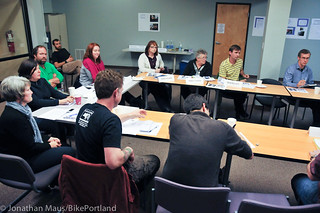
endorse its plan for a road diet on SE Foster Rd.
(Photos © J. Maus/BikePortland)
The Stakeholder Advisory Committee (SAC) for the Foster Streetscape Plan voted overwhelmingly in favor of the Bureau of Transporation’s recommended redesign of Foster Road last night. There was only one committee member who voted against the plan, and none of PBOT’s proposed designs was challenged. However, tempers and emotions flared during the meeting on an issue unrelated to how the lanes and sidewalks should be divided up.
As we shared on Tuesday, after a 10 month public process, PBOT unveiled their proposal for how to turn the notoriously dangerous “Foster Freeway” into a “safe, pleasant, attractive and comfortable place to live, shop and linger.” In short, the design would change the existing, four lane cross section (with on-street parking in some segments), to a more modern lane configuration that would have three standard lanes and two, six-foot wide bike lanes from SE 52nd to 90th.
The reactions to PBOT’s plans here on BikePortland have been mixed. Many people are thrilled that Foster will have dedicated space for bicycling and (most likely) lower speed and calmer driving behaviors. But others were hoping for a more robust bikeway design that would provide some degree of buffer or physical protection.
At last night’s meeting, PBOT project manager Mauricio LeClerc and traffic engineer Lewis Wardrip explained the details of their recommendation and the rationale behind their decisions. They also clarified how the new striping would look at the western end of the project and at a tricky “mixing zone” at SE 82nd.
Here’s the PBOT striping plan for the intersection of Foster and SE 56th:
As you can see, the new bike lanes would vanish suddenly just west of 56th and Foster would return to its existing, four-lane cross-section. One attendee at the meeting last night pointed out how this would “be an awkward transition” if someone was riding westbound and “their lane just ends”. In response, PBOT’s Wardrip said they could put down sharrows or other pavement markings to help with the transition. However, PBOT assumes most people on bikes will turn off of Foster prior to the bike lanes ending. They’ll expect westbound bike traffic to go north at 56th to weave through the neighborhood. For bike traffic coming from the north and traveling eastbound, LeClerc said they could use the future bike lanes on SE 52nd, ride past Foster and then go left (east) on SE Center Street to access Foster.
At SE 82nd, some people were disappointed that westbound bike and auto traffic would mix in a travel lane. Here’s the striping plan for that section PBOT shared last night:
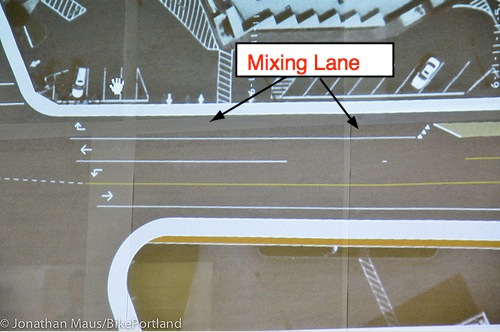
PBOT staff admitted that this design is “not ideal by any means” but that it was the best option available at this time. In order to maintain a dedicated bike lane through the intersection (to the left of a right turn lane), PBOT claims they’d need to acquire several feet of right-of-way from the adjacent bank parking lot. Here’s how that would look (green color would be newly acquired PBOT right-of-way):
Since the design above is beyond the scope of this current project, PBOT said they would include language about pursuing it in the update of the Streetscape Plan. (Note: This Foster striping/redesign is just one project within the larger update to the Foster Streetscape Plan.)
After going over those two issues, LeClerc presented the recommendation and the context behind their decisions (read the draft recommendation PDF here).
One of the projected impacts of PBOT’s recommendation is that average driving speeds during the evening rush-hour would decrease from 19 mph to 14 mph along the 2.3 mile project corridor. Put another way, the new lane configuration (which won’t allow people to pass slower drivers) would lead to a three minute increase in travel timesin the short-term.
“The increase in travel time would go against our goal of equity… I don’t see any people of color around the room… We need to hear more from people with backgrounds who don’t match our own.”
— Nick Christensen, Lents Neighborhood Association
That aspect of the project concerns committee member Nick Christensen. “The increase in travel time would go against our goal of equity,” he shared, via a prepared statement. Christensen, who was the only “no” vote on the recommendation, said people who drive this stretch of Foster would be burdened with an extra 13 hours a year on their commute. “I see benefits to some users and the burdens being shifted to other users.” He also pointed out that the official project goals calling for “smooth, consistent traffic movement” for motor vehicles would not be met with the three-lane/bike-lane configuration.
PBOT’s LeClerc responded to Christensen by saying the design is a compromise of many needs and interests. “On streets like Foster we have to make trade-offs. It’s a balance. This recommendation we believe best meets the objectives.” LeClerc said the city is fully aware of the impact to motor vehicle travel, but said it’s an acceptable trade-off for the sidewalk improvements, bike lane, and the retention of 94% of the existing on-street parking capacity.
When another committee member, Cora Potter, mentioned how the project would place a negative “burden” on motor vehicle drivers, someone else spoke up about the burden the road currently places on bicycle riders and walkers. “I’d say that there’s a burden right now on other users. It takes us more time as bicycle riders and as walkers to cross the street… This current set-up [of the street] hurts a lot of people.”
Committee member Dan Campbell, who said he appreciates the (once controversial) buffered bike lanes on SE Holgate, said that a road diet and other safety improvements PBOT has planned for Foster are “worth making the trade-off” in motor vehicle access.
More support for PBOT’s plans rolled in from committee member Nick Falbo (who’s also a planner at Alta Planning). “I think if we were to put the recommendation on the ground today, it would dramatically transform what it’s like to bike, drive and walk on Foster… I think it will change the whole attitude of what it feels like to move on Foster Road.”
“This process wouldn’t be valid if this was happening on Williams.”
— Cora Potter
A local business owner who sits on the committee, Kelsey Donogoen, said she’s looking forward to the slower auto traffic. “I think it’ll be great to get cars to slow down so they can actually see what they’re driving by.” (The speed limit on Foster is currently posted as 35 mph; but PBOT said they plan to reduce it to 30 once the changes have been implemented.)
It was at this point in the meeting that Nick Christensen raised a concern about the public process and things got a bit heated.
“Look around the room,” Christensen said, “we’re back to the situation where 40% of my community is ethnic or racial minority and I don’t see any people of color around the room. That concerns me that we’re not hearing from a significant amount of our community who have different backgrounds, experiences and values from the people sitting around this table. We need to hear more from people with backgrounds who don’t match our own.”
Committee member Meghan Humphreys responded by saying, “You can’t really at this point say, because nobody fits this diverse community standard, that this is somehow less valid. I don’t believe this process is less valid… I think we need to do more as a community to get people to understand what’s happening here.”
Then meeting attendee and area resident Cora Potter said, “This process wouldn’t be valid if this was happening on Williams.”
“But this isn’t Williams,” Humphreys replied.
“It’s very close to Williams,” said Potter, “There are a lot of people that have been displaced from Williams to our neighborhood and they’re going to see things going on and they’re going to think they’re going to have to move on down the road again and they’re going to be afraid. You need to go them where they are instead of expecting them to come to this meeting.”
At this point, tempers flared and things deteriorated when someone accused Potter of “using the ethnic minority issue to drop a bomb on this project.”
When PBOT’s LeClerc tried to calm things down, by (in part) pointing out that the committee includes Roseva Saa of Portland Mercado (who wasn’t in attendance last night), Potter said Saa’s appointment to the committee was “tokenism” and that Saa had only come to two meetings (out of 10). “When we started this committee,” Christensen then pointed out, “There were no people of color.”
In PBOT’s defense, LeClerc said their plans for Foster, “Benefit people of all ages, ethnicities, and abilities.” He then continued, “I think we’re making it better for everybody. So, regardless of whether we have the representation here or not, I think the recommendation is one that is inclusive of all people… And a higher percentage of minorities use active transportation than the rest of the population.”
“My thinking is that the people of the Mt. Scott and Arleta neighborhoods will make better use of a wide bike lane in this segment than they would of a rarely used parking lane.”
— Nick Falbo, committee member
Before the meeting ended, Nick Falbo presented an idea for how to improve the bikeway between SE 72nd and 80th. PBOT’s current plan is to have a six-foot wide bike lane next to parked cars and a standard lane on the south side and a six-foot wide bike lane next to the curb on the north side. Falbo thinks devoting eight feet of the roadway to car parking isn’t a good use of space, so he proposed eliminating that parking lane, which would allow for a nine-foot wide bikeway on both sides of the street (six for the lane, three for a buffer).
“My thinking,” Falbo explained, “Is that the people of the Mt. Scott and Arleta neighborhoods will make better use of a wide bike lane in this segment than they would of a rarely used parking lane.” Falbo pointed out that this segment is full of popular destinations and that, “The idea that they [nearby residents] could hop on this nice, safe bike lane and end up at the grocery store is very appealing.”
Here’s what the City has planned…
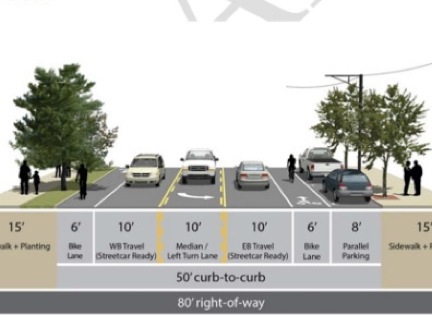
And here’s what Falbo would rather see…
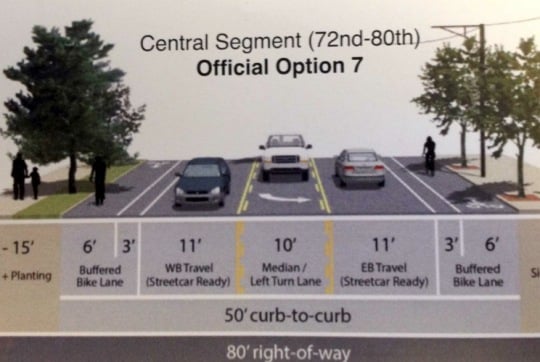
The existing parking lane isn’t needed, Falbo contends, because nearly every business has their own, off-street parking lot.
Reaction to Falbo’s idea was mixed. LeClerc with PBOT said “We’re concerned that businesses will feel an impact,” if on-street parking was prohibited. He and others pointed out that the upcoming Portland Mercado development is expected to attract a lot of customers; many of whom they expect to arrive by car. It wasn’t the response Falbo was hoping for, and it’s not likely PBOT will add his idea to the official recommendation.
With the committee’s full endorsement, PBOT will now continue to present the recommendation to other community groups and eventually plan a public open house. After that, the project will move into the design and engineering phase and it will be officially adopted by City Council later this year. Due to strings attached to the federal funds being used, construction of this project isn’t scheduled until 2016.
— Learn more at our Foster Streetscape Plan story tag or at the City’s website.




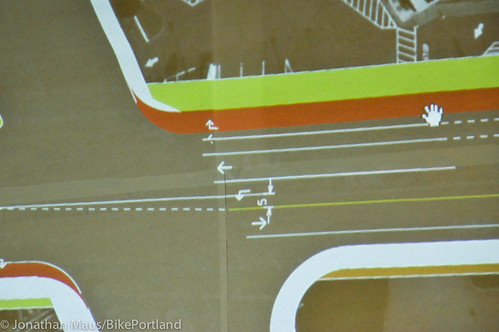
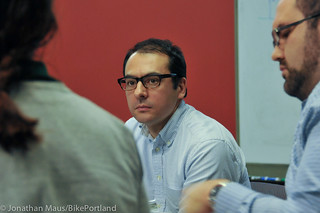
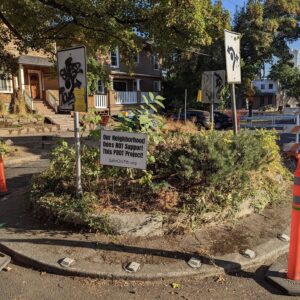
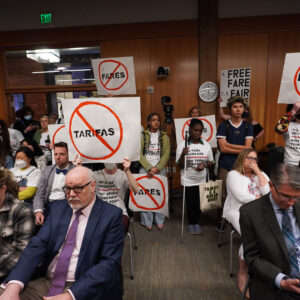
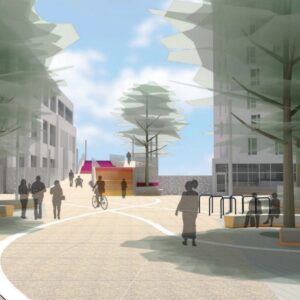

Thanks for reading.
BikePortland has served this community with independent community journalism since 2005. We rely on subscriptions from readers like you to survive. Your financial support is vital in keeping this valuable resource alive and well.
Please subscribe today to strengthen and expand our work.
“but PBOT said they plan to reduce it to 30 once the changes have been implemented.”
Very glad to hear this.
Since bike lanes tend to be successful when the speed differential is lower, I think that a decrease in the speed limit makes the conventional bike lane much more palatable. Nevertheless, a 25 mph speed limit would be more consistent with other 2 lane collecters/arterials in this area.
FYI – http://en.wikipedia.org/wiki/Tokenism
so who did you & nick invite to the table, cora? why did you wait until the last meeting to bring it up?
We didn’t wait until the last minute and actually did involve a lot of folks in our daily conversation. The time of the meeting was difficult for a lot of folks, and one of our more outspoken minority community members that was very interested in the project was not able to participate on an ongoing basis because of health concerns. However, the make up of the committee is PBOT’s responsibility and they make the appointments. I actually wasn’t officially on the committee and only served as an alternate until about halfway through, when the official appointee had to step down because of his schedule. Even then, it took me three meetings (including one I missed due to lack of communication) for them to finally add me to the notification list.
Cora, spot on again.
I wonder what all Asian community thinks about these issues, and the Somali community. I bring up these groups because I see members of this group well-represented in automotive repair and other auto-dependent businesses in outer SE. Recent immigrants from Vietnam may have feelings about cars that differ from those of the BTA.
The Jade District will be very angry once they find out about the city’s decision to label SE 82nd a “F” and permit congestion to discourage driving. I suspect that they will not be happy.
At the first meeting, I noticed that every person who had been appointed to the committee was white. I brought it up then, and PBOT made an additional appointment to the committee. I’ve brought it up many times since then, both publicly at committee meetings and with my community, and privately with civic leaders.
I don’t know that a more diverse conversation leads to a different outcome. I’m just uncomfortable going forward with a recommendation without getting meaningful participation from people who have a different set of life experiences, and hearing what their values are in the future of Foster Road. I’d be saying that no matter what the outcome was.
Let me be clear – I think the other volunteers on the committee have done a good job representing their communities. At the end of the day, though, all of us are influenced by our backgrounds and experiences, and it would have been useful and helpful to have a variety of those backgrounds and experiences influencing the conversation. It was PBOT’s responsibility to ensure that a variety of voices were heard.
Beyond that? I’m not going to get into a comment thread debate, because I think we all know those are about as productive as throwing ice cubes in a river to try to make it colder. Happy to talk it out over a beer some time.
uuuuuuuuuggggghhhhh. Political posturing and gamesmanship over this issue? Barf.
This thing surely moved at a snails pace like anything bureaucratic so I am sure that there were many opportunities for people with concerns about the committee make-up to air them.
The final night seems like a poor choice of times and more like a last ditch effort to derail a process that did not go the way some would have liked to have seen it go.
As Nick said, he brought this up many times in many ways. You can’t fault him for this because you only tuned in at the last minute.
Yes I can. The rest of the committee accomplished a road redesign. Nick and Cora failed to get people they wanted on the committee to attend. Sounds like they are the only two who didn’t accomplish what they wanted to accomplish.
The point being that people that are appointed in numbers where they represent such a low percentage of the total make up of the group rarely feel supported in expressing their opinions or representing differing opinions that they are hearing in their own communities.
they’ve had plenty of opportunity and have been invited to the open community meetings (which I’ve attended many), regardless of your delayed involvement. there are plenty of people along the Foster corridor who want these changes yesterday…not further delayed and mired in additional processes and feel good committee voices. What are these people you claim to represent going to say? they want more death, higher driving speed, less inclusion, more drug abusing transients? additional strip clubs and less liveability? what’s the concern exactly? higher property taxes? the PPS system just took care of that, didn’t it?
do you even know what you’re protesting?
The main concern has been commuting time increases (which I think is valid) and diversion traffic. Mauricio consistently has made the point that there are going to be tradeoffs in this solution.
“commuting time increases”
for whom? Oh, right. Those (still) in cars.
I don’t see any commuting time increases for those who are on bikes, unless the weaving suggested around the intersection at 56th is mandatory. I think the extra time we’ve all been spending on (avoiding) Foster is already banked.
The commuting time increases for the 99% of Outer SE residents who don’t bike will just mean more idling cars & buses on Foster. And, with bike mode share flat for years, despite improvements- the use of cars won’t change. But when I bike down Foster I guess I will just enjoy the extra air pollution.
Wow. You really do take a dim view of all this. How about looking at this as a dynamically evolving situation? Just because biking (in your view) has been flat doesn’t mean it must be forever and ever. And to blame idling cars on those not in cars is a little rich, don’t you think?
A little infrastructural encouragement here; a little hike in the gas tax there; next thing you know climate change bonks us a good one….
If it had been up to you and wsbob I suppose the East Bank Esplanade would also never have seen the light of day.
I get your point. I just don’t believe your sincerity in the way you are using it.
If you tried really hard to get more diversity on the committee and felt like it didn’t happen then the failure was yours. Plain and simple.
This is a pretty good compromise. I was stunned that a large arterial would get road dieted at all. If this can be made to work here, it’s a good example for harder nuts to crack (like Barbur).
And Sandy
and Hawthorne
Hawthorne has an option one block north and south. Hawthorne should be very low on the list for upgrades.
I could not disagree more. If we want cycling to be as convenient as motoring then we need infrastructure on direct routes to major commercial/entertainment destinations. I live in the inner SE and I *never* ride on Salmon or Harrison because Hawthorne, Belmont, and Division get me where I want to go more quickly and more efficiently.
Also your math is flawed — Salmon/Taylor and Harrison/Lincoln are 3-5 blocks to the north and south of Hawthorne.
I find SE Ankeny to actually be faster than Burnside. No lights, and pretty easy crossings.
Salmon is full of stop signs and doesn’t offer prioritized or signalized crossings of several major intersections. Hawthorne has two lanes in each direction, making it easy to pass slower traffic safely, and the speed limit is only 25.
Hawthorne is already congested with 2 narrow lanes each way + parking and restaurants, etc. Why people insist on biking there is beyond me, move over one street! I never biked on Hawthorne, too fast and busy. Heck, even when passing buses in my Suburban I have to move a bit into the oncoming traffic. Usually I wait behind the bus, clogging everything up. This street should be 3 wide lanes with parking left and right and maybe bike lanes.
“even when passing buses in my Suburban”
Hm. Maybe your vehicle is part of the difficulty you’re experiencing. I’ve never found Hawthorne to be too narrow on my bike.
You might find this discussion helpful.
http://bikeportland.org/2012/09/05/what-se-hawthorne-would-look-like-if-our-streets-match-our-rhetoric-76903#comment-3199733
“Why people insist on biking there is beyond me, move over one street!”
Ha. That is funny. I can tell you don’t frequent the area on a bike. Do you know anything about the streets one block over from Hawthorne? Madison is great between 12th and 30th, but it is one way below 12th and interrupted constantly beyond 30th. And don’t get me started on Clay/Market/Ladd’s. There’s a reason–many actually–why we bike on Hawthorne. Time to get used to it.
i love answering this question.
*my destinations are typically on hawthorne.
*i find it convenient to take a full vehicle lane on hawthorne. moreover, this right is reinforced by signs on that dot hawthorne.
*hawthorne has signalled intersections that make passing busy arterials safer and more efficient.
*it’s much safer to cycle at higher speeds on hawthorne than on a narrow neighborhood road.
*when going down hill i often hit green at most traffic signals. (a green wave!)
*i find hawthorne to be a far more interesting route than a sleepy neighborhood road.
I bike Hawthorne whenever I need to, but I appreciate swimming in traffic.
My comment was from a standpoint of money going where it needs to most from the perspective of people who want infrastructure, and I think SE out in to the Hawthorne area has some pretty good options and should be low on the list. Not saying that it couldn’t be remade, just that there are areas that need it more.
I am no good at maths. This is true.
ok…i definitely agree with your comment. still…when the city revisits an arterial we should not miss the opportunity to restripe inexpensively (see Sandy and Lower Division).
Bike lanes on Milwaukie!
“construction of this project isn’t scheduled until 2016.” Really?
Then shouldn’t we collectively think ahead and plan for the future twenty years beyond the year 2016?
Getting input from citizens nearing the rest home in age that drive 1970’s cars is illogical.
Duh, the raised cycletracks for bicycles would be a wise investment to plan for now, to be built starting in 2016.
Having a center turn lane and protected medians for pedestrians are also essential.
This plan fails, hard.
#fail
Hopefully no one dies in the next 3 years.
Thanks for the write up Jonathan.
There will be a 5th open house coming up in November to share the recommendation with the community at large (that’s right, there were 4 previous open houses dedicated to sharing this planning project with the neighborhoods).
The committee meetings are not the end of public participation on a project like this, they’re the beginning. As committee members, we do our best to represent the interests of our groups, neighbors, and community members.
Most of the public participation is through direct presentations to neighborhood groups, business associations, tabling at every community event they can and well-advertised open houses. The last open house we had sent out notices in multiple languages to everyone living with a 1/2 mile radius of Foster, all the way out to 122nd. Attendees to these open houses are diverse and come from all walks of life.
Despite criticisms of the makeup of the committee itself, I think this process has been admirable – it is certainly the most comprehensive planning and outreach effort to come to Foster in a very long time.
And thank you Nick Falbo for advocating for the elimination of on-street parking and raising the idea of a buffered bike lane. PBOT is too fearful of change when it comes to eliminating on-street parking along these corridors (as they were with Williams). We are seeing this tentativeness from them with the 20s bikeway project as well. This raises competition for the remaining street space, and it is often unnecessary since there is abundant off-street parking and on-street parking on neighboring streets. The bike-ped-transit advocacy community needs to proactively push on this…
Thanks for showing up and covering this in person Jonathan.
I was a little disappointed that (even with all the debate on here from the previous article) there was still pretty low turn out from the public (lower than most of the meetings I had been to even).
2016, wow! I live at 54th, really bummed that we will see no change, still four lanes and no bike lane. Was dreaming of looking down the street to something other than a highway.
Especially considering much of this is re-striping (similar to Division). Yes I know there are islands and new sidewalk sections, but that doesn’t need to delay the lane reduction and bike additions.
Infrastructure has no ethnicity.
Of course it does. Dams and Salmon come to mind.
I don’t think the committee or PBOT took an official position on the stopping the westbound bike lane at 56th/Center. I took it as more of laying out the issues and potential costs of trying to route bikes through the neighborhood instead (especially the 9′-wide paved section of 56th). I would hate to see a great bike facility end just blocks from the pending 50’s bikeway (@52nd) and the food cart pod just to gain a handful of parking spots.
I agree with you Brett! Really not enthused about the idea of instead of using the left turn lane from south on 52nd onto Foster the city is proposing to go down to center and then cross both lanes of traffic to turn left. Just seems safer to me to use the actual left turn signal. And traffic is stopped 80% of the time you get to the intersection after crossing Powell.
Regardless I think I’m going to stick to Foster for both of the directions leading to 52nd.
Is it possible that a hysterical concern for “diversity” will just emerge as an excuse to do nothing? People of all colors get lung cancer from air pollution. People of all religions and nationalities get nailed by hit and run drivers. It seems to me that it’s a whole lot more important to break the car-centric transportation culture than count angels on the head of a pin, here.
Right.
But these two related comments just about killed me –
“people who drive this stretch of Foster would be burdened with an extra 13 hours a year on their commute.” (Christensen)
“the project would place a negative ‘burden’ on motor vehicle drivers” (Potter)
I’m sorry, but this is just hard to imagine anyone saying with a straight face. What the heck?! All the damn cars are a *burden* to EVERYONE; they are the wellspring from which sickness, death, ugliness, blight, depressed neighborhoods, foreign debt, climate change, the fact that my child can’t play in the street….. all flow. We’re supposed to pity the guy sitting an extra three #%&$ minutes in traffic on Foster?! forget the road diet because of him?!
What about the extra minutes those who bike incur from weaving through the neighborhood around the intersection at 56th?
“However, PBOT assumes most people on bikes will turn off of Foster prior to the bike lanes ending. They’ll expect westbound bike traffic to go north at 56th to weave through the neighborhood.”
Sorry. Had to vent there for a minute.
I think a key point many forget to add. That these “delays” only apply to the evening commute going one way. The rest of the day 22 out of 24 hours won’t see that much impact (at least according to the models (which I don’t have a ton of faith in to begin with)).
This logic pertains to nearly every street – Foster, Barber, Sandy and all the others. The idea that streets need to be designed with maximum efficiency for auto traffic for only a couple hours for 5 days of the week I find pretty silly, and wasteful both in money and resources.
Streets shouldn’t be designed for peek traffic times, but that the streets should be built for the best and safest access to the neighborhoods that they belong to. Rush hour will always be rush hour, there is no possible way to design or build your way out of it, at least not in land locked cities like Portland. Perhaps you can build your way out in wide open cities like Kansas City or Dallas where there are few natural boundaries to limit expansion, but we don’t have that luxury here. And of course there are other consequences to doing it in those cities too, like central city decay as the populations move outward from the city core (the opposite of Gentrification – see Detroit as the extreme example of this).
168 hours are in a week, peek times for most side streets is perhaps 4 hours a day (2 hours morning/2 hours evening). Lets be generous and make it 6 for our example, the peek traffic model designs for 30 hours of the week, while the other 138 hours of use (which is more local use) is pretty much ignored.
All those streets at non peek time are often pretty wide open and not nearly as busy. Using the metric of peek times in designing streets doesn’t account for the people that live off those streets, it accounts for the people driving through those areas. When they talk of adding “X” number of minutes it is assumed that the driver is driving the whole route from one end to the other, people that live off those streets seldom drive the whole route. Foster might be the one exception, in that people closer to 52nd might take it to the 205, but they might also take Powell which would usually be faster anyway (depending on if they are heading North or South). But most people in the neighborhoods are not subject to the entire commute time increase.
People are going to drive cars whether you like it or not. There is nothing you can do to ever stop that. And they have just as much right to be represented when it comes to the city’s infrastructure.
Sure, but they have had it pretty good for about 90 years. Time for some ‘adjustments.’
Dave, they actually apply to both peak travel times. They only modeled the PM peak, but there will also be AM peak delays.
You say. Anything that isn’t tested should be assumed to support your position?
Existing conditions report page 22. There is an AM peak in the westbound direction that actually exceeds the evening peak, but has a slightly shorter duration.
So, either the increase of capacity use will lead to delays (as it does in the PM peak, predictably) or it will lead to more diversion (most likely to Holgate and Harold, which is not desirable.)
I asked them to run the model on the AM peak, mostly because I am concerned about diversion to Holgate (where there are two school crossing zones and the AM peak coincides with their use). But, they didn’t do it.
“So, either the increase of capacity use will lead to delays (as it does in the PM peak, predictably) or it will lead to more diversion.”
It is too bad that you see this as a zero sum/lose-lose thing. Why not take a more hopeful/positive approach and allow that this change could produce some net benefits? There are, after all folks in this town/your neighborhood who don’t drive. Maybe some of them will be encouraged to show themselves once these changes are made.
Thanks for telling me what I think. Perhaps you want to take a shot at telling me what I do every day as well.
I didn’t tell you what you think; I quoted your comment. Are you saying that my interpretation of your comment as viewing the proposed changes to Foster as a zero sum/lose-lose thing is not accurate?
I have no idea what you do every day.
“It’s too bad you see this as a zero sum/lose-lose thing”.
That would be a quote of what you said about me and it goes on to imply other things about my character.
Did I misunderstand you? The part of your comment which I quoted mentions (only) two outcomes – “more delays” or “diversion,” both of which it seemed you found less than attractive. Can you clarify what you meant?
I’m simply applying the same methodology that led the traffic engineers/modelers to calculate the PM peak delay. It’s not a value judgment.
“It’s not a value judgment.”
Nonsense. You are focusing on two (hypothesized) negative outcomes related to driving, and omitting entirely any (hypothesized) benefits to those not in cars who might take advantage of the adjustments to Foster Rd. Your calculus does not admit the possibility that one outcome of all this might be less total driving, and happier people/neighbors. Seems kind of one-sided to me.
I admit readily that my focus is on bicycling, how the historic imbalance against human-powered mobility can be undone, so am not particularly interested in marginal gains or losses for those still in cars.
We’re talking about the predictions of the models (in response to someone implying that I just made up an AM peak increase in motor vehicle traffic). In this case, the model actually did account for predicted mode split. The increase in non-auto trips was not enough to offset the increase in motor vehicle trips. And, at the proposed capacity, that results in delay or diversion. That’s not me judging- that’s the parameters of the model.
Of course there will be commute time delays. Anyone who thinks that road diets do not slow down traffic….somewhat…during peak travel time is in denial or is spouting rhetoric to placate commuters from outer districts. The point is that for WAY too long safety has been traded off for speed. We are slowly fixing this. Not counting state highways, there are not too many roads left on the east side that have this dangerous four lane configuration. Hawthorne, which has many crosswalks, Sandy (which may be a high crash corridor but also has signalized crossings every few blocks), Halsey and Burnside.
The next one we need to tackle is Burnside (this process is being worked on). Those that are causing the commute time delay: as in the high volume ot SOV’s (single occupancy vehicles) going to work during the weekdays will have to adjust their thinking. They can park and ride, take the bus, or use Powell or the Banfield. That is what they are for. The era of high speed commuter corridors through “inner city” residential neighborhoods is over.
Burnside is a 35+ mph road that practically invites dangerous and aggressive driving. It desperately needs some traffic calming.
“The era of high speed commuter corridors through “inner city” residential neighborhoods is over.”
Word.
I think it depends on what part of Burnside we’re talking about.
Through downtown, W. Burnside cannot be helped by a “road diet”. It needs to be converted to one-way as part of a couplet.
On E. Burnside, the couplet has made auto traffic flow smoothly and calmly (at a sedate 20-25 mph, you can hit every green light) and made room for a decent bike lane eastbound (westbound being downhill, taking the lane works).
On W. Burnside, assuming it were a eastbound one-way, there would be room for two auto lanes, eastbound and westbound separated cycleways, and wider sidewalks to invite foot traffic and allow street trees; no street parking but there isn’t any now. Traffic could be signalized to 20-25 mpg. Burnside is the main street of our central city, and it would look and work great.
On NW Couch, assuming it were a westbound one-way as the other part of the couplet, there would be room for two auto lanes, parking on both sides, and it could also be signalized to 20-25 mph. There would be more traffic than now (about the same volume as NE Couch, which is busy during commute hours but fairly quiet the rest of the day), but that traffic wouldn’t move any faster than it does today.
I know the couplet is controversial, but if W. Burnside in downtown remains two-way, it will never get bike facilities or a road diet. The street simply carries too much traffic; despite no street parking and no left turns, traffic is already badly clogged. If W. Burnside were dieted down, it would be a constant traffic jam, the bike lanes would be just standard painted 5 foot strips, the sidewalks would still be narrow and treeless.
E. Burnside from the river to E. 12th is fine. The bike lane is usable.
E. Burnside east of E. 12th isn’t too bad, I think, but after E. 32nd or so it starts to become a speedway through residential neighborhoods. It definitely needs some calming measures.
W. Burnside west of NW 24th or so isn’t a 35+ mph road, it is a 50+ mph road. I think speeds can reasonably be somewhat higher there, since it isn’t a residential neighborhood. Still, we desperately need a decent bike route over the West Hills and the only realistic place is W. Burnside, so some buffering will be needed.
E. Burnside past 12th is pretty bad during peak hours. I’ve experienced more conflict on this part of Burnside than on Sandy, Chavez, and Division combined.
I was specifically talking about East Burnside from 14th to the top of the hill. The Burnside High Corridor Group has been working on East 14th to 32nd. Specifically, the group was split:
Of those with an opinion, one-half thought PBOT should go back again and look at the possibility of deleting a westbound lane in favor of a center turn lane to provide better crossing access. PBOT initially said no because of the morning rush hour delays and three block line ups. I doubt it will happen, so the preferred traffic calming plan will consist of future crosswalk islands and pedestrian bulb-outs every two blocks with a robust/ controlled crossing every four at a minimum. There was little to no anti-bike sentiment and almost every group spoke up about protecting Ankeny from diversion…..in fact, the local residents wanted DIVERSION there. They requested that Ankeny be turned into “local drivers only.”
The stretch between 41st and the top of the hill at 68th is where I live. It is a nightmare that needs a complete redesign. There is not a single marked crosswalk between 60th and 68th. There are curves which lower visibility and at night….. since locals do not park on the street because they will either get towed in the morning or their car will be totaled by someone running into it…..it turns into a four lane freeway monster with four foot sidewalks two foot from the curb. This also is a “regional Bikeway” in Metro new long range Active Transportation Plan….as in, connect up the bikelanes on 71st with the Greenways of Couch and Ankeny at 41st.
What about the Westside? We all know about Barbur, but Burnside, Naito, and Macadam are hardly comfortable streets to cycle on for long stretches. And I haven’t gotten into the far SW neighborhoods. When will they get some attention?
“Inner city” residential neighborhoods are not exclusive to the Eastside, Terry.
You are absolutely right. Macadam, in particular, really sucks.
You are absolutely correct and I should have been more specific. Since I live in the “Center of the Center of the Eastside” and never go west of the river except for medical or tourism reasons I generally am East focused. The west side is much more constrained because of the hills and the limited access points. We are lucky because of the east side grid.
“Not counting state highways, there are not too many roads left on the east side that have this dangerous four lane configuration.”….I guess I was specific. 🙂
And, let’s not forget (as we both well know), that East of 60th to 82nd, E Burnside is about 99% residential. When I feel uncomfortable standing close to the street to pull my “debris” bins back to the house because cars are going by so close and fast, it is time for a change.
Everyone one of these east side monster arterials needs a protected bikeway of some type, but because of the suburban style growth pattern the solutions are different. I was in a zip car going down 122nd yesterday and noticed how poorly utilized that parking is on that street and kept thinking….this needs to go in favor of a protected bikeway or east Portland will never grown into its biking potential no matter how many greenway residential connections are made.
Thanks for the great coverage, Jonathan. Mauricio has a tough job — you really go into a project like that knowing right up front that nobody’s going to be 100% happy with the outcome.
Sounds like an excellent preview for the 20s Bikeway project…
People are going to keep molesting children, too–so we should make it easier on them???!!!
If equity is going to enter the discussion here, it seems less pertinent to speak in dehumanizing terms about committee members as “tokens” than to address the shift in property values that will likely occur as a result of road design changes. If rents rising along the corridor force more working families further out, will they benefit from a widened bike lane? What steps can the committee take to ensure that more residents can access active transportation, since that would be the ostensible goal of the redesigned street?
My comment about tokenism was not a judgment of Roseva. It was meant to take those responsible for making committee appointments to task for 1. appointing her only after someone pointed out the entirely white (mostly wealthy, college educated, under 40, childless) make up of the committee and
2. appointing her as a single voice, with no peers from the group she was meant to represent to support her
and 3. making only a single appointment of anyone at all – rather than making an honest effort to recruit and choose committee members from a broad range of backgrounds, in numbers where they felt supported
Nick and I did our best to act as go-between communicators. But, as I have always said, I can only speak with people, I can’t speak for them. If I only have one voice at the table and one “vote” I have to try to aggregate a lot of conflicting needs into a single decision and that’s only a single input into a larger committee decision. I honestly think that people should be at the table so that every single committee member has to go through that process of basing their decision on multiple inputs and needs, rather than just representing their own preferences.
“Open Houses” are not a substitute for dialogue.
(mostly wealthy, college educated…childless)
How do you know that?
I am a daily commuter and Foster Rd represents an ideal path for my commute in terms of shortening my commute distance. I do not currently take Foster because it is far too dangerous. The proposal in this article does not change that. It is still FAR TOO (as in, not even close to consideration) dangerous to do every day, year in, year out. Even though it would shorten my commute by at least 2 miles, I would still take Springwater trail everytime. The reason should be obvious. Bike lanes on busy thoroughfares simply do not cut it. We don’t put pedestrians in striped lanes, do we? We put them on a protective curb and line parked cars with it. Bicyclists aren’t any less vulnerable than pedestrians, in fact less so, because we cannot dodge cars as easily. I really don’t get this push to put bike lanes on busy arteries. You might as well save your money for when you can do it right – as in, at least curbing, preferrably concrete barricades. It might be great for the local businesses and local pedestrians to slow down traffic, but from this commuter’s perspective, it would be just a matter of time until I got taken out.
This may still be worthwhile for other reasons, especially for the neighborhood, but for commuting, no way.
We can wait, for decades, to get the expensive separated bike infrastructure you want. Or we can get painted bike lanes on slowed-down “dieted” roads, today. As more people use those painted lanes, then on the streets where even more cycle infrstructure is warranted (considering usage and accidents), there will be more support for it.
I do much of my commute on roads with no bike lanes at all, so something like this would be great.
I agree. As an everyday commuter from Mt. Scott, I still can’t imagine commuting along the proposed Foster re-striping. How can there be any expectation of converting current drivers into to cyclists if experienced riders don’t feel comfortable? I am also fearful that without any reduction in traffic, in jams it will only disperse the current traffic onto other surrounding roads, making them less safe for cyclists who have relied on them.
“if experienced riders don’t feel comfortable”
well I feel comfortable on Foster – now. Not great, but I’m o.k. with it. So perhaps we should allow for a diversity of ‘experienced riders.’
I’m sorry to have used a term that we both feel is appropriate despite our differing experiences. Based on the rare cyclist sighting on Foster’s road, I’d say that you are in the further end of the bell curve for people who would feel comfortable out there. The primary point was to contrast the demographic that the proposal should hope to serve. For you, it doesn’t sound like it will make a huge impact since you will be out there either way, but everyone below your comfort tolerances should be the ones bolstered by the changes, not just another 5-15% of the toughest.
“Based on the rare cyclist sighting on Foster’s road.”
We were talking (mostly) about Foster being (still FAR TOO) dangerous after the proposed changes. I dare say your sense that cycling on Foster is rare now will be less true then.
I see this as a step one, it gets the ball rolling. I have no doubt that once people start using the path, in a couple years the talk will be of removing more of the street parking (which isn’t used much even now) and increasing the size of bike facilities and adding bollards.
But to get that conversation started we need the paths and the ridership numbers. And I’m in the camp of those that do ride Foster now (since no one parks on it, there is usually ample room now for you on many sections), and can’t wait for my own lane. Now we just need a better grocery store in the area (Sorry Freddies, but the Foster one is perhaps the smallest and dirtiest one in the city).
You’ll probably change your tune once the lanes are in and the lanes have been reduced. Division is way better now, and I seldom use Woodward/Clinton now though I live between the two.
The Foster planning is less about the bike lanes than it is about the road diet and safer pedestrian crossings. In some ways, the bike lanes are just icing on the cake.
Maybe someday there will be a separate “Bikeway Enhancement Project” to really sit down and answer the question about how we make a bikeway on Foster comfortable for everyone, but for now, this is what we get.
If you are interested in getting a feel for what the bike lanes on Foster would feel like, check out NE Glisan in the 20s, or SE 7th between Division and Morrison. Both of these streets have 3-lanes, high volumes, and regular bike lanes next to parking.
In fact, Foster’s wider 6 ft bike lanes might feel even better than those streets, which gives me hope that it will be use by more than just the strong and fearless.
Thanks for putting it that way. It makes more sense, despite the disappointment of incremental steps.
Both of those sections of NE Glisan and SE 7th are very rideable. Try it.
I would go so far as to say that relatively few cyclists would consider NE Glisan from Sandy to NE 39th to be “too dangerous” to ride.
At the end of the day, a bicycle is an unprotected, two wheeled conveyance, so riding a bicycle in the city is going to carry some irreducible level of risk.
Ask our brethren on motorcycles. With 100X the horsepower of the strongest cyclist, vastly better brakes and tires, twenty pounds of protective armor, and better training than most cyclists, motorcycle riders still have significantly higher risk of death/injury than car drivers.
“With 100X the horsepower of the strongest cyclist, vastly better brakes and tires, twenty pounds of protective armor, and better training than most cyclists, motorcycle riders still have significantly higher risk of death/injury than car drivers.”
Except that we don’t.
The two wheel similarity is I think far less crucial than the horsepower/speed thing that motorcycles have going.
It is the unnerving vs unsafe thing again.
Stats I see say that a motorcycle is 25x riskier than a bicycle, “per trip”.
A bicycle is only about 2x riskier than a car, also “per trip”. About the only thing to learn from motorcycle safety experience is “don’t ride a motorcycle”.
“It is still FAR TOO (as in, not even close to consideration) dangerous to do every day, year in, year out.”
Can you be more specific? I’ll grant that it can be unnerving, but what about biking on Foster do you consider now (or under the proposed conditions) to be dangerous? What in your mind makes commuting special such that these terms are unacceptable to you?
Again, this speaks of the need to place absolute limits on property values–acknowledge that it’s a part of the free market that has FAILED!!!
I’m not a huge fan of gentrification, though being a property owner in this area I do stand to gain from it. But I will say that that the other option isn’t any better, which is to let the neighborhoods continue to decline.
Typically leaving areas alone pushes the decline along slowly, as wages continue to remain stagnate (as they have for the last 40 years), costs continue to rise for maintenance of properties making it harder for people to afford the keep up on the properties. Which then contributes to the further the decline of neighborhoods as the properties start to degrade.
Is there a balance to found somewhere in between? Perhaps. But it is a very fine line to balance on. Neighborhoods need fresh development and money to keep them vital, but to constrain the amount of value that can be asked for to keep rent prices down will limit the amount of individual and industry investors.
Are there are areas where price controls has worked well? Some have been more successful than others, but on a whole but all are controversial and they should be we are after all talking about peoples homes.
But the evolution of neighbor hoods happen, one way or another, naturally. Having lived here for 20+ years and been one that lived in NW and Alberta just before (or as the first wave) of gentrification started there is a kind of natural flow to how it happens, and it has little to do with what the city does, other than protect the Urban Growth Boundary.
It has more to do with cheap properties and the young artsy people and recent immigrants that buy and start fixing up those properties. They get the ball rolling because they buy the cheap fixer uppers for themselves, open a cafe, shop, or gallery near by and give the buildings good bones. As they slowly develop the neighborhoods (usually pretty bumpy process with the locals) the younger families start moving in, this intern improves the schools and parks in the areas, then the developers and investment buyers start taking the neighborhood seriously. And things really get going.
Very true. When bought my house 10 years ago it was an asbestos covered eyesore overgrown with invasive plants. You could hardly see it. An Angry Walnut became mad at me during a storm, which allowed me to use the insurance money to strip and restore the exterior. Then we removed the plants and landscaped….within a few years house after house got painted one house after another were “spruced up.” Both blocks in either directions now have been “redone” and we are the longest term residents in either direction so they do not know how run down the block was.
Our neighborhood is considered now in “Stage one” of early gentrification as the four days on the market for the only uninsulated house on the block told is. I can not wait until the paperwork goes through and I can see what they paid for it.
The trick is to balance availability with affordability. What we need is more flexibility with ADU’s and sustainable infill. There is no reason we can not update our zoning laws to allow for smaller sized eco-homes to be built on current lots taking up unused old style garage space or back corners. We need to make these rules much more flexible or the economy will continue to dictate “tear down,sub-divide. rebuild.”
Did anyone mention the sex businesses on lower Foster? They drag the neighborhood down. There is something surreal about the fact that the
existence of the businesses is ignored. Prostitution of young women by ugly old johns (I see them on my way to work in the a.m.).
If there was a time and place to remove street parking- it would be outside of the jack shacks. I would crack up to see bike racks. Make
the johns walk a few blocks.
The PDC looks so foolish when they throw little improvements at that area. Trash cans on the street, litter outside the strip club, illegal A signs, and illegal activity within. How about a safe place for the sex workers’ needles? It is the grossest part of the city.
it should be noted that Foster between 50th and 52nd is a FIVE lane “freeway”, which often extends that fifth lane east to Bush as people prepare for the existence of the fifth lane…
it seems like bad planning to terminate the bike lane only 2 “Foster” blocks (3-4 city block numbers) shy of where it widens to more lanes…
56th is the nearest cross-street to me, so I would be just getting onto Foster at 56th to go west towards Hawthorne for grocery shopping…
I only turn off of Foster onto neighborhood streets because I have to… I’d much rather stay on Foster… the few times that I have I discovered some cool little shops hidden within the blight…
One more bit of math here. If the time estimates are correct this leads to an increase of 2.6 mins each way. For someone who commutes 250 days per year, that is 10.8 hours in each direction.
I’m curious for an update (from someone other than Joseph Rose) on this.
Amazing that a project this large for bicycling in Portland did not get more coverage here… As many have probably found out, it was unanimously passed by City Council last week. See Foster United for a non-O writeup: http://fosterunited.org/streetscape-approved-5-0/
Thanks very much for the link.
“City engineers project that in 30 years, the “road diet” configuration would cause 1 minute of additional travel time for motorists driving the length of the project area during rush hour.”
That was a good laugh. What engineer in their right mind is going to predict something that precise, that miniscule, 16 years out? In 16 years… we’re going to be enjoying hours more travel time – on our donkeys and rickshaws and cargo bikes. By then there may well not be such a thing as rush hour anymore. Funny people.